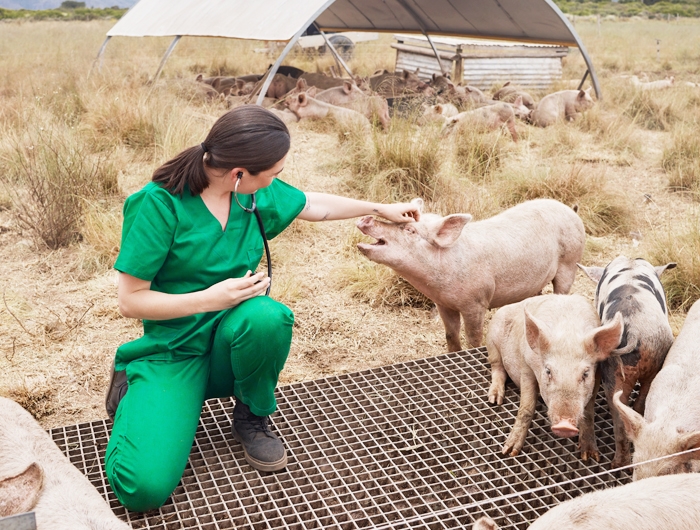Overlooked but essential: The role of public health veterinarians in food safety

PeopleImages - istockphoto.com.
The United States Department of Agriculture is considering a move to reduce food safety monitoring by public health veterinarians. Should consumers be worried?
In a system that has been in place for decades, federal public health veterinarians play an indispensable role in protecting the food system—working in slaughterhouses to inspect live animals and carcasses. They often act as the frontline guards against zoonotic diseases — those that cross over from animals to humans—and help ensure compliance by regulated industry. Their ability to effectively conduct these tasks is rooted in a veterinary doctoral degree consisting of four years of intensive medical training.
However, the role of these public health veterinarians is now at risk. In a story first reported by Food Safety News, as a result of public health veterinarian shortages, the U. S. Department of Agriculture’s Food Safety and Inspection Service (FSIS) appears poised to reduce the current roles of veterinarians and hand many of their current responsibilities over to less qualified non-veterinarian workers.
Through FSIS, veterinarians help to ensure that meat and poultry entering the food system is both safe and of a quality that consumers would expect. For example, prior to slaughter, they inspect live animals to ensure they are not sick or diseased. After slaughter, they inspect the carcass to identify lesions, like internal cancerous lesions, parasites, or extreme bruising, which indicate diseases that could have escaped notice in the live animal evaluation. Perhaps most critically, they oversee food safety plans created by establishments, which are key to preventing the spread of foodborne hazards like Salmonella and Campylobacter.
FSIS veterinarians also conduct foreign animal disease surveillance by looking for specific signs of these diseases on live animals and their carcasses. These diseases are not historically native to the United States and can enter the country through the importation of animals, animal products, or other contaminated objects. These diseases can rapidly spread through domestic animal populations, leading to extensive outbreaks and deaths of animals with devastating economic impacts. For example, the 2014 outbreak of avian influenza caused more than 50 million birds to die or be killed, and $3.3 billion in losses.
In addition to public health protection, FSIS veterinarians help protect animals by enforcing animal welfare laws and regulations to ensure humane handling and proper slaughter techniques that minimize trauma to the animals. These techniques are not only important for animal welfare, but food animals with lower stress levels at slaughter can have higher quality meat. For example, pigs handled more roughly during slaughter have lower blood pH and higher levels of inflammatory markers, leading to poorer meat quality due to a metallic taste and paler color.
Nonetheless, in its most recent report, USDA notes that in 2020, 18 percent of their public health veterinarian positions remained open, a jump from previous rates of 10-12 percent. This high vacancy rate could be caused in part by the low government starting pay for these positions, especially at FSIS. The average veterinary student exits veterinary school with about $190,000 in loans. Entry-level public health veterinarians working at FSIS may expect to start only around $60,000 per year, while starting clinical veterinarians typically earn more than $100,000.
By contrast, the federal government has made greater strides in paying physicians, who have similar qualifications and debt loads as veterinarians, but better federal compensation. Take, for example, the prestigious Epidemic Intelligence Service Fellowship at the Centers for Disease Control and Prevention; the starting pay for veterinarians in this position is $76,000 while physicians start at $96,000. Or take the government-wide physician comparability allowance, which allows physicians to be paid anywhere from $14,000 to $30,000 per year on top of their regular pay for positions in which there is an unacceptable number of vacancies. Because this program doesn’t exist for veterinarians, USDA attempted its own retention and recruitment plan for public health veterinarians, but it pales in comparison to the physician version, allowing for $5,000 extra per year at most. While a gap in pay between veterinarians and physicians exists in the private sector, the generally lower federal salaries likely make these differences especially unattractive to veterinarian job seekers with comparably high debt loads.
Though details of FSIS’s proposal remain to be publicly announced, it’s clear the agency is considering giving responsibilities currently carried out by veterinarians to non-veterinarians, with the goal of having fewer empty positions as fewer veterinarians would be needed for the same number of establishments. Of course, this would save the agency money as well.
This approach is not a strategic or sustainable solution to the problem of vacancies. Not only does it have the potential to further exhaust current veterinarians if they are expected to each cover more establishments, but it would leave the food system less protected as less skilled workers are asked to take on the responsibilities previously assigned to veterinarians.
Such changes also fail to address the underlying problem, which is that FSIS has failed to offer competitive compensation for these highly trained workers. Rather than minimizing the role of veterinarians, FSIS should instead be focused on valuing veterinarians more to increase applications and fill vacant spots.

